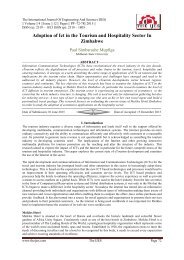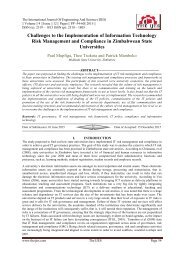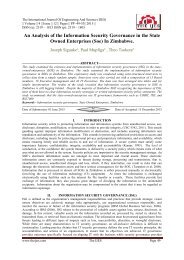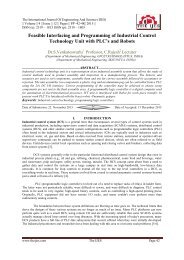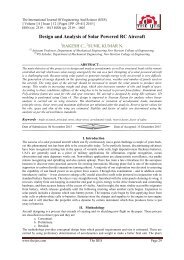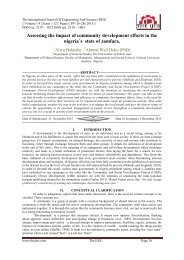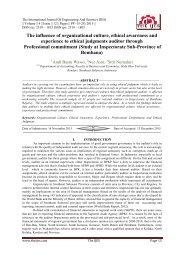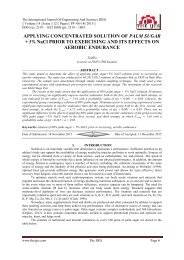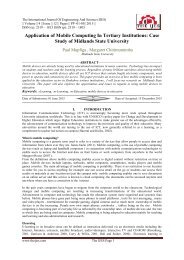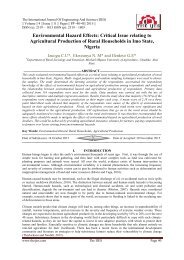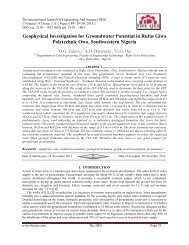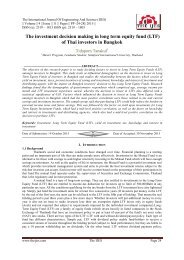Adaptive Image Contrast with Binarization Technique for Degraded Document Image
Create successful ePaper yourself
Turn your PDF publications into a flip-book with our unique Google optimized e-Paper software.
<strong>Adaptive</strong> <strong>Image</strong> <strong>Contrast</strong> With <strong>Binarization</strong>…<br />
(c) BACKGROUND SUPRESSED RECOVERED TEXT IMAGE<br />
IV. CONCLUSION<br />
This paper presents an adaptive image contrast based document image binarization technique that is<br />
tolerant to different types of document degradation such as uneven illumination and document smear. The<br />
proposed technique is simple and robust, only few parameters are involved. Moreover, it works <strong>for</strong> different<br />
kinds of degraded document images. The proposed technique makes use of the local image contrast that is<br />
evaluated based on the local maximum and minimum. The proposed method has been tested on the various<br />
datasets. Experiments show that the proposed method outper<strong>for</strong>ms most reported document binarization<br />
methods in term of the F-measure, pseudo F-measure, PSNR, NRM, MPM and DRD.<br />
REFERENCES<br />
[1] B. Gatos, K. Ntirogiannis, and I. Pratikakis, “ICDAR 2009 documentimage binarization contest (DIBCO 2009),” in Proc. Int.<br />
Conf. <strong>Document</strong> Anal. Recognit., Jul. 2009, pp. 1375–1382.<br />
[2] I. Pratikakis, B. Gatos, and K. Ntirogiannis, “ICDAR 2011 documentimage binarization contest (DIBCO 2011),” in Proc. Int.<br />
Conf. <strong>Document</strong> Anal. Recognit., Sep. 2011, pp. 1506–1510.<br />
[3] I. Pratikakis, B. Gatos, and K. Ntirogiannis, “H-DIBCO 2010 handwritten document image binarization competition,” in Proc.<br />
Int. Conf.Frontiers Handwrit. Recognit., Nov. 2010, pp. 727–732.<br />
[4] S. Lu, B. Su, and C. L. Tan, “<strong>Document</strong> image binarization using background estimation and stroke edges,” Int. J. <strong>Document</strong><br />
Anal. Recognit.,vol. 13, no. 4, pp. 303–314, Dec. 2010.<br />
[5] B. Su, S. Lu, and C. L. Tan, “<strong>Binarization</strong> of historical handwrittendocument images using local maximum and minimum filter,”<br />
in Proc.Int. Workshop <strong>Document</strong> Anal. Syst., Jun. 2010, pp. 159–166.<br />
[6] G. Leedham, C. Yan, K. Takru, J. Hadi, N. Tan, and L. Mian, “Comparison of some thresholding algorithms <strong>for</strong> text/background<br />
segmentation in difficult document images,” in Proc. Int. Conf. <strong>Document</strong> Anal.Recognit., vol. 13. 2003, pp. 859–864.<br />
[7] M. Sezgin and B. Sankur, “Survey over image thresholding techniques and quantitative per<strong>for</strong>mance evaluation,” J. Electron.<br />
Imag., vol. 13,no. 1, pp. 146–165, Jan. 2004.<br />
[8] O. D. Trier and A. K. Jain, “Goal-directed evaluation of binarization methods,” IEEE Trans. Pattern Anal. Mach. Intell., vol. 17,<br />
no. 12, pp. 1191–1201, Dec. 1995.<br />
[9] O. D. Trier and T. Taxt, “Evaluation of binarization methods <strong>for</strong> document images,” IEEE Trans. Pattern Anal. Mach. Intell.,<br />
vol. 17,no. 3, pp. 312–315, Mar. 1995.<br />
[10] A. Brink, “Thresholding of digital images using two-dimensional entropies,” Pattern Recognit., vol. 25, no. 8, pp. 803–808,<br />
1992.<br />
[11] J. Kittler and J. Illingworth, “On threshold selection using clustering criteria,” IEEE Trans. Syst., Man, Cybern., vol. 15, no. 5,<br />
pp. 652–655, Sep.–Oct. 1985.<br />
[12] N. Otsu, “A threshold selection method from gray level histogram,” IEEE Trans. Syst., Man, Cybern., vol. 19, no. 1, pp. 62–66,<br />
Jan. 1979.<br />
[13] N. Papamarkos and B. Gatos, “A new approach <strong>for</strong> multithreshold selection,” Comput. Vis. Graph. <strong>Image</strong> Process., vol. 56, no.<br />
5, pp. 357–370, 1994.<br />
[14] . Bernsen, “Dynamic thresholding of gray-level images,” in Proc. Int. Conf. Pattern Recognit., Oct. 1986, pp. 1251–1255.<br />
[15] L. Eikvil, T. Taxt, and K. Moen, “A fast adaptive method <strong>for</strong> binarization of document images,” in Proc. Int. Conf. <strong>Document</strong><br />
Anal. Recognit., Sep. 1991, pp. 435–443.<br />
[16] I.-K. Kim, D.-W. Jung, and R.-H. Park, “<strong>Document</strong> image binarization based on topographic analysis using a water flow model,”<br />
Pattern Recognit., vol. 35, no. 1, pp. 265–277, 2002.<br />
[17] J. Parker, C. Jennings, and A. Salkauskas, “Thresholding using an illumination model,” in Proc. Int. Conf. Doc. Anal. Recognit.,<br />
Oct. 1993, pp. 270–273.<br />
[18] J. Sauvola and M. Pietikainen, “<strong>Adaptive</strong> document image binarization,”Pattern Recognit., vol. 33, no. 2, pp. 225–236, 2000.<br />
M.Tamilselvi was born in Vellore, Tamilnadu, India in 1983. She received his Bachelor Degree in Electronics and<br />
Communication Engineering from C.Abdul hakeem college of engineering and technology, Anna university affiliated in<br />
the year 2005, Master Degree in VLSI Technology from Sathyabama University in the year 2012. She is working as<br />
Assistant Professor in Department of ECE in Jeppiaar Institute of Technology. His interested areas of research are <strong>Image</strong><br />
Processing and VLSI Design. She is a member of International Association of Engineers (IAENG).<br />
www.theijes.com The IJES Page 23



